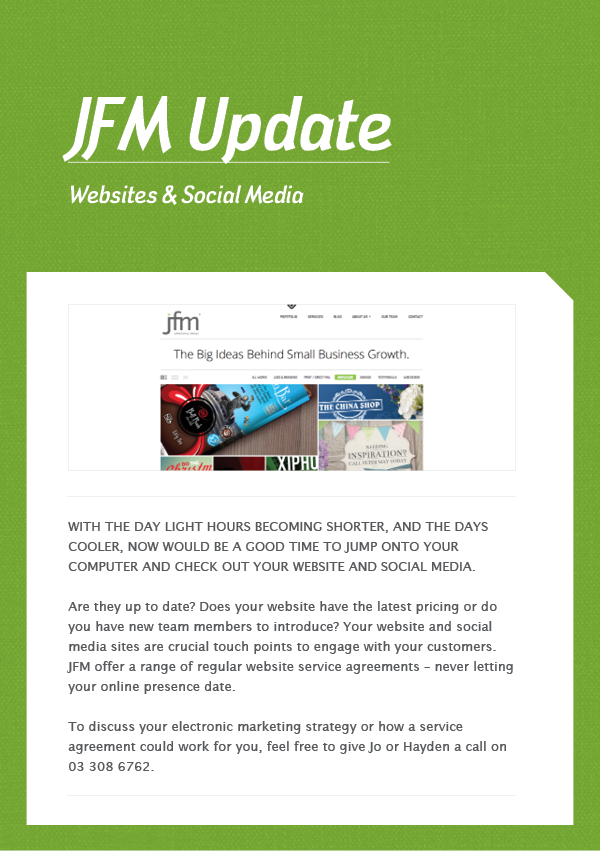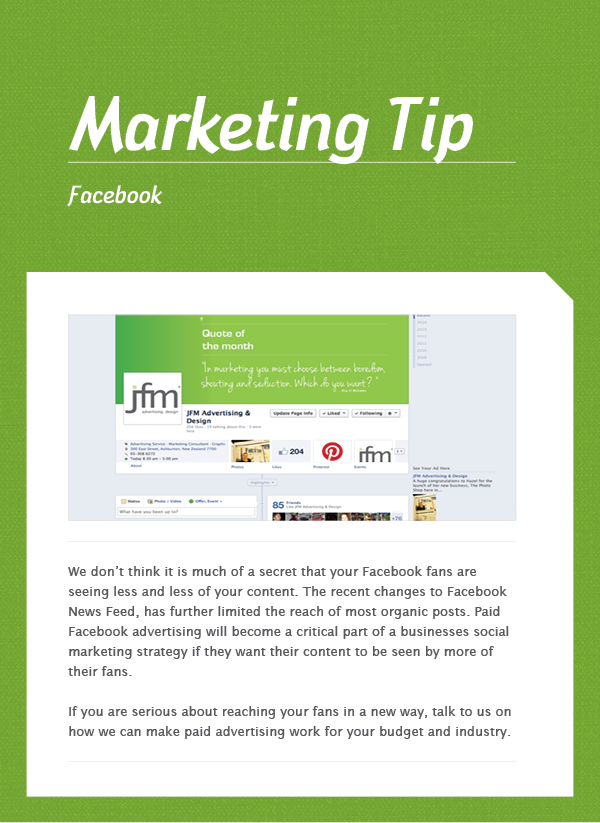
JFM MAY NEWSLETTER – QUOTE


Here you can find out what instance options Vision Insurance can provide for you.
Simply click here to view now.






I enjoy waving my pitchfork in the face of change as much as the next citizen, but to be fair it’s just too early to tell whether Spark will work as a brand. At first hearing, Spark sounds like an odd name for a telco, but I think that’s partially the point. We’re all talking about the rebrand aren’t we? Opinions dissecting the wisdom of Spark have flooded social media and workplace discussions across the nation, but at the very least everybody knows the new name.
At this point, we don’t know enough about what’s behind the brand strategy and how it will be implemented in the marketplace. Whether New Zealand accepts or rejects Spark as a brand will depend on the conversations surrounding it over coming months. It seems to be the done thing for a creative agency to dismiss the work done by anyone else, but respect where respect’s due – with talented thinkers like Interbrand and Saatchi involved in this rebrand, the rationale behind Telecom’s name change will be compelling.
Without knowing what objectives were detailed in the brief given to Interbrand and Saatchi, I can see some obvious reasons why Telecom might feel a name change was timely. To begin with, Telecom is stepping up to acknowledge that the telco market is fast evolving into a content-led beast. For instance, a consumer might buy one telco device every five years, but they will happily chew through data on a daily basis as they download entertainment to that device. Also, depending on your loyalties, it can be argued that Telecom has attracted some fairly negative customer sentiment over the past few years – mainly around product failures and a perceived lack of customer service. Telecom will probably be seeing an advantage in wiping the slate clean by moving on from negative associations tied to the Telecom brand name.
As a name, Spark will definitely sit comfortably amongst brands which appeal to younger tech-savvy consumers who evaluate new products or services on the basis of what they deliver, rather than what they’re called. This demographic is completely comfortable with a seemingly nonsensical brand names, as this keeps the brand free of confined meanings attached to an everyday word and gives the consumer more room to create their own ”story” with a peer group of likeminded brand supporters. Twitter anyone? Google it. After you’ve finished Flappy Bird.
On the other hand, Telecom will be aware that leaving behind the Telecom brand name will also risk leaving behind long-term customers who’ve stuck with Telecom this far. A large part of their long-term loyalty will be based on knowing what to expect from the Telecom they’ve been with for years and years. These customers are probably more conservative in their habits, and, at first, they won’t necessarily relate to Spark as a brand-name. But Spark is just a new name to learn. In time, customers will attach their own deeper meanings to that name.
And there sits the elephant in the room.
A brand isn’t a business name. A brand isn’t a logo. These two things are elements of a brand, but they should be built upon an understanding of what the customer wants from a business. A brand is not a manufactured shiny widget which a business can whip up in-house and send out for the masses to admire. The value of a brand is created by individual customer perceptions of a business or product. A brand is everything a business represents to the market. That may sound like the sort of overpriced jargon you’d expect from a snappy dressed pony-tail, but think of all the associations which pop into your mind when I mention a brand like Rolls Royce. I bet you don’t just think of their logo. The reality of creating a modern brand is first accepting that a brand exists in the hearts and minds of a marketplace. It then becomes a little easier to work strategically on controlling the brand by creating targeted marketing messages and delivering on the promises you’re giving to the market.
Building a great brand takes strategy, consistency and time. It’s about giving the consumer a range of opportunities to connect with a business in very real, very positive ways. To be seen as a different company from Telecom, Spark will need to deliver a different customer experience from Telecom. Changing the name and logo is easy, but changing customer perceptions by living up to new promises will be the real test of success for Spark.
Nik Sweeney – JFM Advertising & Design, Senior Graphic Designer
